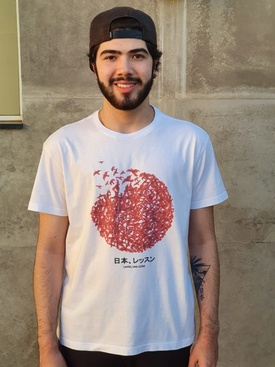Reuniting with nostalgic Japanese songs
During the stay-at-home period, I started to exchange more videos of Japanese TV programs and Japanese pop songs with my friends. The first video that arrived on my smartphone was "Ue o Muite Arukou." I felt very nostalgic when I heard Kyu Sakamoto's voice singing it. This is because this song was the theme song of the radio program I hosted from 2001 to 2007. Every morning, with that beautiful melody and lyrics playing in the background, I greeted the viewers with "Ohayo Bondia" and introduced a number of Japanese songs.
Then I found out that this famous song was being sung by 16 popular Japanese singers at home, and the compilation of the songs was creating a stir online. The title was "Let's cheer up Japan! Let's all sing 'Ue o Muite Arukou'". It was released to bring energy and hope to the world amid the impact of the COVID-19 pandemic, and I was moved when I heard the song. My friend, who is not familiar with Japanese songs, wanted to know the names of all the singers in order.
This kind of collaboration was also carried out among Japanese singers in Brazil. They sang the world-famous song "We are the World" not only in English, but also in Japanese "Kokoro wo Hitotsu ni" (Let our hearts be one) and Portuguese "Um só coração" (Um só coração). This was also distributed as a video. Also, a video produced by a group of Japanese people in 2014 to commemorate the 80th anniversary of Londrina has been re-released to support those staying at home. This video introduces the voices of a Londrina civic group singing "Hana wa Saku" (Flowers Bloom), a charity song produced to support the recovery from the Great East Japan Earthquake (2011), along with scenery of the city. This is one of the videos that warms my heart as someone who has just started living in Londrina. My friends are also getting a lot of energy from these songs.
Even if the songs are not specially made like this, Japanese songs in general seem to give a lot of energy to Japanese Brazilians. "In fact, one of my friends told me, 'Please keep sending them to me. My brother-in-law hasn't been feeling well since he got sick, but listening to Japanese songs cheers him up.'" Also, on Mother's Day, many Japanese Brazilian mothers received song videos of "Mother's Song" and "Message to Mother," and they all said they were very touched.
Additionally, Japanese songs of various genres, such as "Sarai" (1992), "Kaze ni Tatsu Lion" (1987), "Kimi to Itsumademo" (1965), "Arigataya Arigataya" (1960), "Kanpaku Sengen - Parody" (2020), and "Kanpai" (1980), have recently been shared among Japanese Brazilians. Many people heard these songs for the first time since staying at home, and my friend said that even though he didn't understand the lyrics very well, he liked them because they were Japanese.
It's not just Japanese songs that are entertaining Japanese Brazilians who are staying at home. There are also radio exercises, muscle training, refreshing exercises, Japanese proverbs, TV commercials, Okinawan grandmothers making pickled radishes, and many other things that are giving us Japanese Brazilians energy in the midst of the coronavirus pandemic. Strangely enough, during the pandemic, Japanese Brazilians seem to be more attracted to "Japan" than before.
Breno admires Japan
Breno is my paternal cousin's grandson and a 17-year-old high school senior. I first met Breno a year ago, and I was impressed by the "Japan" tattoo on his left arm, which he got to pay tribute to his beloved great-grandfather. He had been staying with a host family in Canada since August last year, but returned to Japan early due to the impact of COVID-19.
Immediately after returning to Japan, my cousin contacted me and told me happily, "Brenno has decided to learn Japanese! He borrowed a book from an acquaintance and has started studying." It is wonderful that Breno, a fifth-generation Japanese who grew up in an environment without exposure to Japanese culture, wants to study Japanese. I immediately delivered a trilingual dictionary to him.
Since he is interested in Japan, we started exchanging emails. I introduce him to online Japanese language courses, Japanese movies, and information about NHK World Premium programs. He is very interested and asks me many questions, so we have a lot of fun communicating with each other.
As we talked, I learned that Breno is aiming to enter the Faculty of International Relations and become a diplomat and work in Japan after graduation. I was surprised! It reminded me of myself. When I was Breno's age, my father told me, "Laura, you're suited to diplomacy." In the end, I went on to study Japanese Language and Literature, but I still can't forget what my father said. And since my first visit to Japan in 1972, my dream has been to work in Japan. My cousin supports Breno, saying, "It's genetic." I also cheer on Breno as he works hard.
Meeting new friends
June 18th marks the 112th anniversary of Japanese immigration to Brazil, and on the 16th I was invited to a video conference on "Japanese Brazilian Literature" organized by the Group for the Study of Oriental Culture (GPECO) of the Department of History at the State University of Londrina.
The person in charge of this conference was graduate student Ueno Magalhães Martina Luana, who I first came into contact with when she chose my first published novel, "Sonhos Bloqueados," for her master's thesis before I had even considered moving to Londrina.
During this video conference, we had the opportunity to talk about the environment depicted in "Sonhos Bloqueados," why we chose a Japanese-Brazilian as the main character, readers' reactions, and comments from people in the literary world.
This book was published on June 18, 1991, so it felt very strange to talk about it now, 29 years later, but since it was a video conference, I was able to make the presentation without any nervousness. Also, being able to share my journey as a Japanese-Brazilian novelist with the younger generation at this conference was one of the wonderful experiences I had during the pandemic. It reminded me that I want to continue writing as my purpose in life.
Future daily life
After staying at Hatsuko's house for a month, I returned home and finished the renovation, and I am still staying at home. As I get older, I feel like I'm gradually understanding how to make myself feel comfortable. At a time when people all over the world are living in sadness, loneliness, and anxiety, I just spend every day thanking God. I just hope that everything will return to normal soon.
© 2020 Laura Honda-Hasegawa






